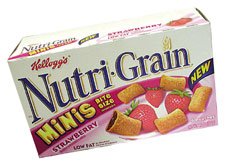
Fruit of the Grain
Scientific advances and commercial efficiency have allowed the food industry to derive maximum use of commodity agricultural products, including grains.Nutri-Grain Minis, one of the latest creations from Kellogg USA, Battle Creek, Mich., exemplifies this trend, as well as the trend toward “downsizing” a food's physical dimensions.
Grain-derived components listed on the tasty, fruit-filled snack's label include ingredients such as whole grain oats, wheat bran, gluten and enriched flour, as well as various cornstarches. Grains, however, are the raw material for other ubiquitous additives appearing on many foods' labels such as high fructose corn syrup, dextrin, acidifiers and others.
Mintel International's GNPD, Chicago, records dozens of cereal-based products introduced around the world under the Kellogg's Nutri-Grain brand. For example, it notes that the company launched in 1997 in the U.K. “a breakfast cereal bar available in three flavours: strawberry; blueberry; and apple & cinnamon. They are 92% fat-free, low in saturates and are described as a healthy snack for consumers who have no time for breakfast.” In 1998, a “neu” ready-to-eat muesli breakfast cereal was introduced in Germany. South Korea, Austria, South Africa and France are just some of the other countries whose citizens are consuming Nutri-Grain snack bars for “breakfast on the run.”
www.kelloggs.com/products/nutrigrain — Nutri-Grain web page
www.rab.co.uk/case_studies/html/NUTRIGRAIN.html — Case study on the use of radio for the U.K. marketing launch of the Nutri-Grain bars

An Anecdote on an Alkaline Food
Anecdotal evidence (i.e., from the woman stocking the shelves at a Whole Foods grocery) indicates that this Organic™ Food Bar from Bio International, Fullerton, Calif., is very popular among store patrons.The product is unusual for several reasons. Its label declares that it is a 90% alkaline-forming food. The company notes that it utilizes “organic almond butter and rice protein in our bars due to the fact that they are easily digested, and have a neutral or even alkalizing effect on the blood and cellular tissue.”
Since sustained activity creates excess lactic acid in the body, to then “consume products that are also acid-producing—including every other bar available—simply adds to the problem.”
The product also makes use of several high-end grain ingredients such as organic quinoa sprout powder, organic fava bean sprout powder, and organic soy sprout powder—among others. Its website reports that fava bean sprouts are the “world's highest natural source of dopa, a natural precursor to dopamine.” The phytosterols /sterolins on the label are derived from sprouted barley, lupin, fenugreek, African potato, sunflower and flaxseed. And, the final ingredient? “A pinch of love.”
www.organicbar.com — Bio International's website for this product

A Not so Little Sprout
Sprouted grains are seen in a number of baked goods at natural health food stores. The concept behind the use of such grains is that the enzymes produced during sprouting convert starch into more digestible maltose, and the vitamin and mineral content available for digestion increases. In effect, the sprouting process “pre-digests” grains.Sprouted grains, however, can present a manufacturing challenge due to greater variability in starting material such as moisture content. And, many products must be frozen through distribution.
Alvarado St. Bakery, Rohnert Park, Calif., has a line of sprouted baked goods including breads, tortillas, pizza breads, hot dog buns and bagels.
At the end of 2002, a sprouted grain and seed bread named “Food For Life Genesis 1:29” was introduced by the Food For Life Baking Company Inc., Corona, Calif. The sprouted grains and seeds listed on its ingredient legend include wheat, corn, soybeans, chia seeds, barley, millet, rye, brown rice kamut and a number of others, including teff. Teff grain is purported to be used in Ethiopia, Australia and India, but is little known elsewhere in the world.
www.alvaradostreetbakery.com/faq_asb.html#1 — Alvarado St. Bakery's FAQ page on sprouted wheat
www.gov.mb.ca/agriculture/livestock/nutrition/bza17s01.html — A study on the impact of sprouted grain feed for livestock
www.mda.state.mn.us/mgo/crops/Teff.htm — Information on teff grain
www.foodforlife.com/faq.asp - Information on advantages of spouted grain
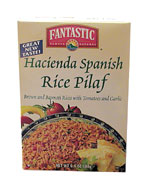
Rice Relations
Fantastic Foods Inc., Petaluma, Calif, gives a new taste to an old grain. Its Hacienda Spanish Rice Pilaf, based on basmati rice, has a wealth of savory components such as garlic and onion powder, dehydrated cilantro, natural flavors (containing wheat and torula yeast), and a spice mix.However, rice itself can possess a subtle flavor, particularly the aromatic basmati or jasmine. The GNPD lists basmati as a component in some 98 foods introduced globally since January 2002. For example, the Belgium company Boost Nutrition describes a new 85% basmati, 15% wild rice mix as a “fragrant rice mixture.”
On an economic front, rice also can be both an inexpensive “commodity” to round out a formulated prepared food. Happily, with much of the world's population building meals based on rice, it fits nicely into current consumer interests in ethnic dishes from the Far East, Latin America, Mediterranean and Middle Eastern Foods.
www.ricegourmet.com/Recipes.htm — A website with global rice-based recipes from Azerbaijan to the West Indies
www.PreparedFoods.com/archives/1997/180.htm — An overview of various rice ingredients and where they can be used
www.PreparedFoods.com/archives/1999/9910/ 9910flavorsec.htm — Seasonings and a recipe that is useful for rice-based side dishes
www.PreparedFoods.com/archives/1998/9809/ 9809ricesalad.htm

“Wheatless” in Seattle
When walking through recent Natural Product Expos, a number of products that make claims of being wheat- and/or glutenfree were observed. Mintel International's GNPD, however, lists 35 records (foods and beverages) in North America in 2001 with the phrase “gluten free,” while only 21 records appear for the year 2002.The primary target demographic group for gluten-free products is people with celiac disease. This is an autoimmune inflammatory condition also known as Gluten-Sensitive Enteropathy (GSE). The protein gluten is not limited to wheat, of course. Gluten-sensitive individuals may also have issues with rye, barley and, possibly, oats.
When people with the disease consume products containing gluten, their immune system responds by damaging the small intestine. This potentially leads to a range of problems such as malnutrition. Additionally, there is increased risk of osteoporosis and iron deficiency, and more immediate conditions such as abdominal distension and diarrhea.
According to the National Institute of Diabetes & Digestive & Kidney Disease of the U.S. National Institutes of Health, some 1 in 4,700 Americans have been diagnosed with celiac disease. It is the most common genetic disease in Europe, with approximately one in 250 Italians and one in 300 Irish suffering from the malady. Many Americans are of European descent and, since the disease has a genetic basis, it is surprising to note that it is rarely diagnosed in the U.S. Several reasons are given on the NIH website, such as misdiagnosing symptoms and attributing them to other problems. A 1998 study (by T. Not, et al.) suggests that perhaps one in every 250 Americans may have it.
Food for Life's millet-based, wheat-free bread and French Meadow's, Minneapolis, Minn., kamut-based products are shown here.
In 2002, Ener-G Foods, Seattle, Wash., introduced a range of wheat-free, gluten-free foods including hot dog buns, chocolate hazelnut cookies, and sesame crackers. Other products introduced in 2002 making claims to being wheat-free include a Hearty-Rye, All-Natural Whole Grain Crispbread under the Kavli brand from International Food & Beverage, Rancho Santa Margarita, Calif.

www.niddk.nih.gov/health/digest/pubs/celiac/index.htm#7 — National Institute of Diabetes & Digestive & Kidney Disease statistics on celiac disease
www.uams.edu/celiac/review/GSE1.htm — University of Arkansas Celiac Disease Resource for Medical Professionals
Some of the information in this article was derived from Mintel International's Global New Products Database, www.gnpd.com, 312-932-0400. Both photos and product information in "Going Global" was derived from the international database.
For more information on the GNPD, send an e-mail to kthackston@mintel.com.

Sidebar: Going Global
More is more is a philosophy held by many, including some who formulate and market grain products. . .as shown by “the battle of the grains.”
At the beginning of 2001, Riso Gallo in the U.K. extended its range of premium, Italian risotto rice-based products with a 3 Grains item that also contained spelt and pearl barley. It is to be used as a base for soups and salads.
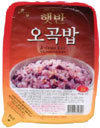
A five-grain rice side dish was just introduced into South Korea by Cheil Jedang under its own brand. The product is 51% rice, with the other four grains consisting of sorghum, millet, small red beans and black rice.
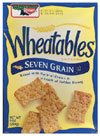
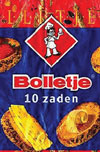
However, leave it to the good old U.S. to win with an artisan, “15 Grain” bread that was introduced under the Safeway Select brand by Safeway, Pleasanton, Calif. The GNPD does not list its contents. Someone please buy one to find out.
Sidebar: Basic Black
Offering multi-sensorial interest, black grains are making their own statement. With the outer hull still intact, they are visually striking, pleasantly chewy and possess a nut-like flavor. They generally take longer to cook; however, their superior nutritional value more than compensates.With origins from ancient Ethiopia, black barley transcends the ordinary pearled barley. Thanks to its shiny outer bran coat, it cooks up to a sheen. Common in soups and stews, it does double duty as a puffy grain and thickener, but also holds its own as side dish, stuffing or main ingredient in a salad.
Small, smooth and elegant, black quinoa can be likened to the “caviar” of grains. A powerhouse of protein, calcium and iron, it is considered the most nutritionally complete. However, this ancient native South American staple, which actually is a seed, cooks in just 15 minutes. Its unique wild flavor and textural characteristics make it an ideal stand-in for recipes calling for grains. Adding substance to soups, stuffing and side dishes, its outer shell delivers crunchiness while preventing stickiness, especially in salads.
With hundreds of varieties native to Asia, black rice transforms to a deep purple color after cooking. Especially popular in Myanmar (Burma), Thailand, Malaysia, Indonesia and the Philippines, it is typically more glutinous than other types of rice and goes well with sugar, making it an ideal ingredient in desserts. It can be used in puddings, cakes and snacks—as well as a sweet morning treat. In Vietnam, it is wrapped in a banana leaf, steamed and served for breakfast.
—Eric Carré, Exec. R & D Chef/Founder, ErdaTek, Inc., www.erdatek.com, 877-377-9797
 Claudia Dziuk O'Donnell is Chief Editor and Associate Publisher of Prepared Foods magazine including its NutraSolutions and Culinary sections. Her responsibilities include determining the editorial content of the print publication and the New Products Conference.
Claudia Dziuk O'Donnell is Chief Editor and Associate Publisher of Prepared Foods magazine including its NutraSolutions and Culinary sections. Her responsibilities include determining the editorial content of the print publication and the New Products Conference.